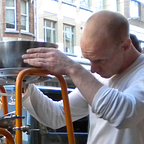Q is for electric charge
Nature has revealed its secret forces very slowly. First fire, then water, only recently electricity. Fire could be used for warmth, to see in the dark, and to cook food. With water thirst can be quenched, and dirt can be washed off, but it can also make wheels turn and store energy for later use. Fire and water were already being used for centuries, if not millennia, when humans started to ask the notorious question “how”: how does heat consume its fuel, how does water make a wheel turn.
The story of electricity runs in a different direction. It is the desire to understand the quirky phenomenon that reveals its potential practical uses. Similarities with other natural phenomena give early investigators the words to describe electricity, like power, current and flow. At the same time, it inspires potential uses: storing energy, powering machines, producing heat and light.
In the mid 17th century, electricity was still a subject of amazement and entertainment, rather than invention and industry. Already then, it had been known for many centuries that when a piece of amber was rubbed with fur, the stone would attract lightweight objects. Greek philosopher Thales of Miletus had described in 600 BC how he managed to attract feathers and other objects with a rubbed piece of amber. The phenomenon inspired English natural philosopher William Gilbert, at times when Shakespeare was writing Hamlet and Cervantes published Don Quichote, to coin the word “electricity”, from the Latin ‘electrum’ or the Greek ‘electron’, both meaning ‘of amber’. Yet nobody was thinking of electricity as a force equal to fire.
The taming of this force happened only slowly and piecemeal. Through a combination of experiment and deep thinking, electricity could be used to drive engines, light up the dark, even for communication. Considering electricity as a force, there are only 4 things we can do with it: generate it, store it, restrict its flow or make it stronger.
Only a century ago, electricity investigators made a leap that would transform the world: use electricity to think instead of humans, and to remember, allowing those thoughts to be shared over space and time. It would launch the information age.
Computers and other electronic devices that think and remember instead of us, have become impossible to ignore in our daily lives. They wake us up in the morning, are the tools that connect us to other people, are essential equipment in the majority of professions and play a part in most leisure activities; the list is sheer endless.
Yet to most people computers and other electronic devices remain as mysterious as earthquakes or hurricanes. They make use of them every day, but because they have no idea of what happens behind the screen or under the bonnet, many are a slave to the machine rather than making the instrument work for them. Also, because they don’t know what happens, many have to rely on the advice of experts. In one of the most important industries in the global economy, expertise is hard to distinguish from advertising, just like the expert is from the marketeer.
What we plan to do in a series of articles is share some basics understandings we obtained from working on La Pile in Brussels. It is not a consumer guide, nor an Electronics for dummies, but it wants to publish some lessons learned. We do so to allow others to learn from the experiments, be inspired by them, but also to reduce our fear of machines and make us a tiny bit more empowered in the electronic world that surrounds us.
In the 200 years from the first scientific interest in the phenomenon to the early 20th century, several devices were built and constantly improved in order to make electricity, store it, restrict and strengthen electricity. In the run up to an exhibition on the subject, which will run from 10 to 24 May 2019 in Bozar in Brussels, and to a wide audience workshop on 12 May 2019 on the same location, we will be having a closer look at each of the 4 things you can do with electricity.
